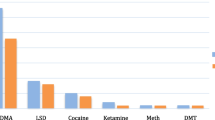Abstract
Purpose
Caffeine has desired stimulant effects similar to but weaker than both classical recreational drugs and novel psychoactive substances. This study was undertaken to determine the caffeine content of a sample of novel psychoactive substances, and we discuss the implications for the management of acute recreational drug toxicity.
Methods
Six novel psychoactive products (‘legal highs’) that were not declared to contain caffeine were purchased from different Internet suppliers; one additional product was supplied by the UK police force. Analysis of these products was undertaken using infrared spectroscopy (IR), gas chromatography with mass spectrometry (GC-MS) and liquid chromatography with tandem mass spectrometry (LC-MS-MS) to identify the active ingredient(s) and measure the caffeine content of the product.
Results
All seven products, which weighed approximately 1 g each, contained only caffeine as the active pharmacological compound. There was significant variation in the percentage caffeine content (<2 to 96%), with four powders containing very significant caffeine contents of 87–96%.
Conclusion
This study shows that individuals are at risk of significant caffeine toxicity related to the high caffeine content of some novel psychoactive substances. Clinicians, including clinical pharmacologists, need to be aware of this to ensure that the management of acute recreational drug toxicity is appropriate and that over-correction of any hypokalaemia does not occur.
Similar content being viewed by others
References
EMCDDA (2010) EMCDDA–Europol 2010 annual report on the implementation of Council Decision 2005/387/JHA. http://www.emcdda.europa.eu/attachements.cfm/att_132857_EN_EMCDDA-Europol%20Annual%20Report%202010A.pdf. Accessed 11 Aug 2011
Hillebrand J, Olszewski D, Sedefov R (2010) Legal highs on the Internet. Subst Use Misuse 45:330–340
Dargan PI, Sedefov R, Gallegos A, Wood DM (2011) The pharmacology and toxicology of the synthetic cathinone mephedrone (4-methylmethcathinone). Drug Test Anal 3:454–463
Lidder S, Dargan PI, Sexton M, Button J, Ramsey J, Holt DW, Wood DM (2008) Cardiovascular toxicity associated with recreational use of diphenylprolinol (diphenyl-2-pyrrolidinemethanol (D2PM)). J Med Toxicol 4:167–169
Wood DM, Dargan PI, Button J, Holt DW, Ovaska H, Ramsey J, Jones AL (2007) Collapse, reported seizure—and an unexpected pill. Lancet 369:1490
Wood DM, Ramsey J, Dargan PI (2008) Detecting novel and emerging recreational drugs on the ‘club scene’. Irish Psychiatrist 9:223–228
Brandt SD, Sumnall HR, Measham F, Cole J (2010) Second generation mephedrone. The confusing case of NRG-1. BMJ 341:c3564
Brandt SD, Freeman S, Sumnall HR, Measham F, Cole J (2011) Analysis of NRG ‘legal highs’ in the UK: identification and formation of novel cathinones. Drug Test Anal. doi:10.1002/dta.204
Ramsey J, Dargan PI, Smyllie M, Davies S, Button J, Holt DW, Wood DM (2010) Buying ‘legal’ recreational drugs does not mean that you are not breaking the law. QJM 103:777–783
Davies S, Wood DM, Smith G, Button J, Ramsey J, Archer R, Holt DW, Dargan PI (2010) Purchasing ‘legal highs’ on the Internet–is there consistency in what you get? QJM 103:489–493
Berger AJ, Alford K (2009) Cardiac arrest in a young man following excess consumption of caffeinated "energy drinks". Med J Aust 190:41–43
Seifert SM, Schaechter JL, Hershorin ER, Lipshultz SE (2011) Health effects of energy drinks on children, adolescents, and young adults. Pediatrics 127:511–528
Trabulo D, Marques S, Pedroso E (2011) Caffeinated energy drink intoxication. BMJ Case Rep. doi:10.1136/bcr.09.2010.3322
Clauson KA, Shields KM, McQueen CE, Persad N (2008) Safety issues associated with commercially available energy drinks. J Am Pharm Assoc 48(3):e55–e63
Reissig CJ, Strain EC, Griffiths RR (2009) Caffeinated energy drinks—a growing problem. Drug Alcohol Depend 99:1–10
US Dept of Health and Human Services (2010) FDA Warning Letters issued to four makers of caffeinated alcoholic beverages. http://www.fda.gov/NewsEvents/Newsroom/PressAnnouncements/ucm234109.htm. Accessed 11 Aug 2011
Cole C, Jones L, McVeigh J, Kicman A, Syed Q, Bellis M (2011) Adulterants in illicit drugs: a review of empirical evidence. Drug Test Anal 3:89–96
Passmore AP, Kondowe GB, Johnston GD (1986) Caffeine and hypokalemia. Ann Intern Med 105:468
Gennari FJ (1998) Hypokalemia. N Engl J Med 339:451–458
Huxtable RJ (1992) Physiological actions of taurine. Physiol Rev 72:101–163
Kendler BS (1989) Taurine: an overview of its role in preventive medicine. Prev Med 18:79–100
European Commission (1999) Opinion on caffeine, taurine and D-glucurono-γ-lactone as constituents of so-called "energy" drinks. http://ec.europa.eu/food/fs/sc/scf/out22_en.html. Accessed 11 Aug 2011
Food Standards Agency (1998) Joint Food Safety Standards Group food surveillance information sheet number 144. Survey of caffeine and other methylxanthines in energy drinks and other caffeine-containing products (updated). http://archive.food.gov.uk/maff/archive/food/infsheet/1998/no144/144caff.htm. Accessed 11 Aug 2011
Shum S, Seale C, Hathaway D, Chucovich V, Beard D (1997) Acute caffeine ingestion fatalities: management issues. Vet Hum Toxicol 39:228–230
Leson CL, McGuigan MA, Bryson SM (1988) Caffeine over-dose in an adolescent male. J Toxicol Clin Toxicol 26:407–415
Fisher AA, Davis MW (2002) Serotonin syndrome caused by selective serotonin reuptake-inhibitors-metoclopramide interaction. Ann Pharmacother 36:67–71
Boyer EW, Shannon M (2005) The serotonin syndrome. N Engl J Med 352:1112–1120
Waring WS, Laing WJ, Good AM, Malkowska AM (2009) Acute caffeine ingestion: clinical features in patients attending the emergency department and Scottish poison centre enquiries between 2000 and 2008. Scott Med J 54:3–6
Conflicts of interest
None declared.
Author information
Authors and Affiliations
Corresponding author
Rights and permissions
About this article
Cite this article
Davies, S., Lee, T., Ramsey, J. et al. Risk of caffeine toxicity associated with the use of ‘legal highs’ (novel psychoactive substances). Eur J Clin Pharmacol 68, 435–439 (2012). https://doi.org/10.1007/s00228-011-1144-y
Received:
Accepted:
Published:
Issue Date:
DOI: https://doi.org/10.1007/s00228-011-1144-y




